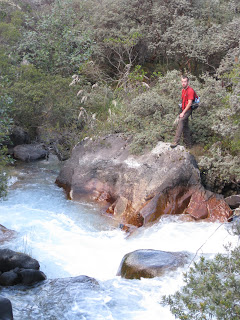
All photos and text by Sally Kneidel, PhD, at sallykneidel.com
Ever read "Snows of Kilimanjaro" by Ernest Hemingway? Some of those famous Kilimanjaro glaciers have been around for at least 11,700 years, and survived a drought 4200 years ago that lasted 300 years. But pretty soon, those legendary snows and ice fields will be gone - another casualty of global climate change.
Or so says glaciologist Dr. Lonnie Thompson and his colleagues from Ohio State University. Thompson and his team used data from aerial surveys and field studies to assess changes in the glaciers of Tanzania's Mount Kilimanjaro. The field studies included glacial drilling to measure changes in depth. Writes Thompson, "Of the ice cover present in 1912, 85% has disappeared and 26% of that present in 2000 is now gone." The rate of melting is accelerating, reports Thompson in the Proceedings of the National Academy of Sciences.
The ice masses of Kilimanjaro are both receding up the peak, and they're thinning dramatically. Kilimanjaro's Southern Ice Field, 21 meters thick in 2000, lost 5.1 meters between 2000 and 2007.
As the glaciers retreat and break into smaller pieces, the dark rocks become exposed and absorb more sunlight than the white ice, thus heating up faster than the ice and accelerating the melting of the surrounding ice. At the documented rates of melting, Kilimanjaro's ice fields could disappear by the year 2022, according to Thompson and his colleagues in their online article in the November 2 Proceedings of the National Academy of Sciences.
Alan Kneidel by a stream of springtime glacial melt.
Photo by Sally Kneidel, PhD
Photo by Sally Kneidel, PhD
The climatological phenomena occurring on Kilimanjaro are thought to be applicable to other tropical peaks, such as those in the Andes. Says Ted Pfeffer, a glaciologist at the University of Colorado in Boulder, these studies will help predict when other tropical glaciers will melt and disappear. Many of these tropical glaciers provide water for people downhill, by way of seasonal glacial melt that is replenished by winter snowfall.
Above, a seasonal pool of glacial melt in the Cordillera Blanca of the Peruvian Andes. The melted snow has, for thousands of years, been replenished during normal winters. Photo by Sally Kneidel, PhD
Above, a Quechuan family in the Andes. They have depended on seasonal glacial melt for their herding and farming needs for generations, with ancient stone aqueducts to funnel the melt to their farms. Photo by Sally Kneidel, PhD

Above, another Quechuan family of farmers and herders in the valley below Mt. Huascaran, the highest tropical peak in the world. Photo by Sally Kneidel, PhD
What will happen when glacial melt is no longer available to communities living on and below the world's peaks? Lives will change, people will move.....who knows beyond that.
Thompson's recent publication was likely one of the studies that contributed to the Copenhagen Diagnosis. One of the conclusions of the Copenhagen Diagnosis, in its Executive Summary, is as follows:
"Acceleration of melting of ice-sheets, glaciers and ice-caps: A wide array of satellite and ice measurements now demonstrate beyond doubt that both the Greenland and Antarctic ice-sheets are losing mass at an increasing rate. Melting of glaciers and ice-caps in other parts of the world has also accelerated since 1990."
So...stay tuned. Let's see what the conclusions are from the climate summit in Copenhagen. Will we all be advised to give up animal products? That would be the easiest and fastest thing to do, since Worldwatch Institute concluded that 51% of annual worldwide greenhouse-gas emissions are from livestock. I'm waiting for President Obama to tell us what we're going to do as a nation. If he doesn't include the fact that we now eat more animal products per capita than any other country, I'm going to suspect that he's not reading all the news.
This post now a Google News Link and posted on www.basilandspice.com.
Sources:
L.G. Thompson et al. "Glacier loss on Kilimanjaro continues unabated." Proceedings of the National Academy of Sciences. 11/2/2009.
Sid Perkins. "Mount Kilimanjaro could soon be bald: world renowned ice caps may disappear by the 2020s." Science News. 12/5/2009.
Copenhagen Diagnosis, Executive Summary. 2009
Sally Kneidel, PhD, "Livestock responsible for 51% of annual worldwide greenhouse-gas emissions".
Robert Goodland and Jeff Anhang. "Livestock and Climate Change: What if the key factors in climate change are cows, pigs, and chickens?" Worldwatch 22(6):10-19. Nov/Dec 2009.
Key words:: melting ice caps Kilimanjaro rising sea levels climate change











1 comment:
This has nothing to do with the deforestation on the slopes of Kili? It is a proven fact that global warming is not the culprit. The cycles of the mountain have been destroyed by mans need for agricultural land. The water at the base of KIli is no more, It has moved miles from there by the stupidity of man destroying the trees.
Post a Comment